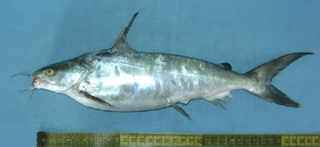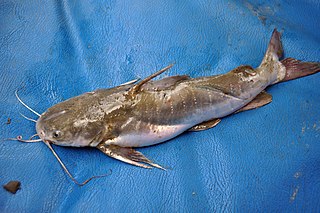
The giant catfish, also known as the giant sea catfish, giant salmon catfish, giant marine-catfish, or the khagga, is a species of catfish in the family Ariidae. It was described by Eduard Rüppell in 1837, originally under the genus Bagrus. It inhabits estuaries and occasionally freshwater bodies, in Japan, Australia, Polynesia, southern Vietnam in the Mekong Delta, the Red Sea and the northwestern Indian Ocean. It dwells at a depth range of 10 to 195 m. It reaches a maximum total length of 185 cm (73 in), but usually reaches a TL of 70 cm (28 in).
The bronze catfish, also known as the giant catfish, the roundsnout sea catfish, or the two-line sea catfish, is a species of catfish in the family Ariidae. It was described by Achille Valenciennes in 1840, originally under the genus Bagrus. It inhabits marine, brackish and freshwaters throughout the Indo-western Pacific. It reaches a maximum standard length of 62 cm (24 in).

Neoarius berneyi, the highfin catfish, Berney's catfish, Berney's shark catfish, or the lesser salmon catfish, is a freshwater sea catfish that is commonly kept in aquariums. The origin of the name Neoarius berneyi is Greek, with the genus name Neoarius coming from the words neos meaning new and arios, meaning warlike or hostile, in reference to the well developed fin spines, and the species name, berneyi, comes from the ornithologist F. L. Berney.

Neoarius is a genus of sea catfishes found on and around the island New Guinea and Australia. They are found in marine, brackish waters and fresh waters with several species restricted solely to freshwater rivers. There are currently 10 described species in this genus.
Patricia J. Kailola is a noted ichthyologist. Her primary focus is in tropical Indo-Pacific fishes. She has worked in the Marine Studies program at the University of the South Pacific since 1995 and is an Australian Museum Research Associate. Among her numerous publications are listed several books covering tropical fish. She also has written texts on catfish. As of April 2006, she was working on a textbook on Western Indian Ocean fishes. She has assisted the Australian Museum in confirmation of species identification among their collection. Worldcat.org lists 27 works in 57 publications in 1 language and 603 library holdings.

Genidens genidens, the Guri sea catfish or marine catfish, is a species of catfish in the family Ariidae. It was described by Georges Cuvier in 1829, originally under the genus Pimelodus. It is known from southern South American rivers connected to the Atlantic Ocean. It is known to reach a total length of 42.5 cm (16.7 in), but more commonly reaches a TL of 35 cm (14 in). It has been recorded spawning between Autumn and Spring. Its diet includes polychaete worms, plants, finfish, mollusks, and benthic crustaceans.

Hexanematichthys sagor, the Sagor catfish, Sagor sea catfish, Sunda sea-catfish, marine catfish or dusky catfish, is a species of catfish in the family Ariidae. It was described by Francis Buchanan-Hamilton in 1822, originally under the genus Pimelodus. It inhabits estuaries and freshwater bodies in numerous areas of the Indo-Western Pacific ocean. It reaches a maximum total length of 45 cm (18 in), more commonly reaching a TL of 30 cm (12 in).

Nemapteryx caelata, the engraved catfish or engraved sea catfish, is a species of catfish in the family Ariidae. It was described by Achille Valenciennes in 1840, originally under the genus Arius. It inhabits marine and brackish waters in Bangladesh, India, Myanmar, Pakistan, Sri Lanka, and Thailand. It reaches a maximum total length of 45 cm (18 in), more commonly reaching a TL of 24 cm (9.4 in).
Neoarius leptaspis, the salmon catfish, boofhead catfish, freshwater forked tailed catfish, lesser salmon catfish, or triangular shield catfish, is a species of catfish in the family Ariidae. It was described by Pieter Bleeker in 1862, originally under the genus Hexanematichthys. It inhabits marine, brackish and freshwaters in Australia and New Guinea, at a maximum known depth of 135 m (443 ft). It reaches a maximum standard length of 60 cm (24 in).
Neoarius latirostris, the broad-snouted catfish, is a species of catfish in the family Ariidae. It was described by William John Macleay in 1883, originally under the genus Arius. It inhabits freshwater rivers in Indonesia and Papua New Guinea. Its diet includes finfish, mollusks, prawns, terrestrial arthropods, aquatic insects, and plants. It reaches a maximum standard length of 50 cm (20 in).
Neoarius midgleyi, the silver cobbler, Lake Argyle catfish, Lake Argyle silver cobbler, Midgley's catfish, Ord River catfish, shovel-nosed catfish, or shovelhead catfish, is a species of catfish in the family Ariidae. It was described by Patricia J. Kailola and Bryan E. Pierce in 1988, originally under the genus Arius. It inhabits brackish and freshwaters in northern Australia. It is known to reach a maximum standard length of 140 cm (55 in), but usually reaches an SL of 50 cm (20 in).
Neoarius utarus, the northern rivers catfish or salmon catfish, is a species of catfish in the family Ariidae. It was described by Patricia J. Kailola in 1990, originally under the genus Arius. It inhabits freshwater bodies in Indonesia and Papua New Guinea.
Neoarius velutinus, the papillate catfish, is a species of catfish in the family Ariidae. It was described by Max Carl Wilhelm Weber in 1907, originally under the genus Hemipimelodus. It inhabits freshwater lakes and rivers in New Guinea. Its diet includes mayflies and other terrestrial and aquatic insects, detritus, benthic algae, and crustaceans.
The Arafura catfish, also known as the Arafura sea catfish, is a species of catfish in the family Ariidae. It was described by James Douglas Ogilby in 1898, originally under the genus Arius. It inhabits marine, brackish and freshwaters in the western Pacific. It reaches a maximum standard length of 46 cm (18 in).
The longsnouted catfish, also known as the Broadbent's catfish, the spoon-nosed catfish, the large-scaled catfish, the sharp-headed catfish, or the sand catfish, is a species of catfish in the family Ariidae. It was described by Achille Valenciennes in 1840, originally under the genus Arius. It inhabits brackish and marine waters in New Guinea, Australia, and southern and southeastern Asia. It reaches a maximum total length of 50 cm (20 in).

The blacktip sea catfish, also known as the Dussumier's catfish, the giant marine cat fish, the Shupanga sea catfish, or the tropical seacatfish, is a species of catfish in the family Ariidae. It was described by Achille Valenciennes in 1840, originally under the genus Arius. It inhabits rivers and marine waters ranging between Africa and India in the Indo-western Pacific. It dwells at a depth range of 20 to 50 m. It reaches a maximum standard length of 62 cm (24 in), and a maximum weight of 1.4 kg (3.1 lb).
The flatmouth sea catfish, also known as the flat-mouthed catfish or the flatmouth catfish, is a species of catfish in the family Ariidae. It was described by Francis Day in 1877, originally under the genus Arius. It inhabits estuaries and coastal marine waters in India, Myanmar, Bangladesh, Sri Lanka, and Pakistan. It dwells at a maximum depth of 50 m (160 ft). It reaches a maximum total length of 31 cm (12 in).
The Mozambique sea catfish, also known as the Mozambican sea catfish, is a species of catfish in the family Ariidae. It was described by Pieter Bleeker in 1846, originally under the genus Arius. It inhabits marine and freshwaters in the western Pacific and western Indian Ocean. It reaches a maximum standard length of 35 cm (14 in).

The Pemecou sea catfish, also known as the flapnose sea catfish, the mud cuirass, or the gillbacker, is a species of catfish in the family Ariidae. It was described by Marcus Elieser Bloch in 1794, originally under the genus Silurus. It inhabits marine, brackish and freshwaters in Brazil, Guyana, French Guiana, Colombia, Suriname, Venezuela, and Trinidad and Tobago. It dwells at a depth range of 1 to 5 m. It reaches a maximum total length of 94.2 cm (37.1 in), while males more commonly reach a TL of 30 cm (12 in) and females reach a TL of 62.5 cm (24.6 in). It reaches a maximum weight of 1.5 kg (3.3 lb).
Sciades paucus is a species of catfish in the family Ariidae. It was described by Patricia J. Kailola in 2000, originally under the genus Arius. It inhabits freshwaters in Australia. It reaches a maximum total length of 130 cm (51 in), and a maximum weight of 2.8 kg (6.2 lb).






